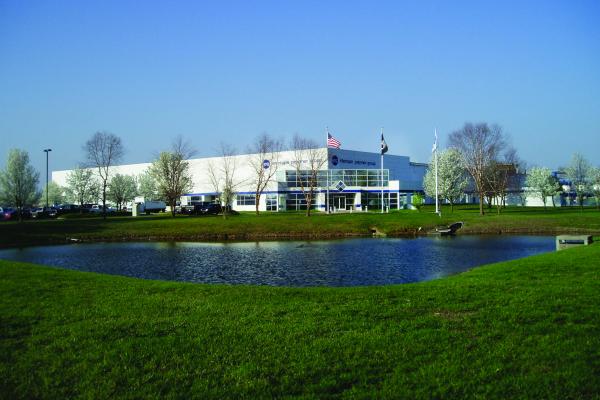Energy Manager
In February 2021, Chiller & Cooling Best Practices Magazine interviewed members of the Intertape Polymer Group Inc. (IPG) Sustainability Pillars team to gain an understanding of the work being done to improve energy efficiency. The team members interviewed were Michael Jones (Director of Corporate Energy), Michael Deitering (Senior Project Engineer), Jarrod Knapp (Maintenance Manager) and Mark Secord (Engineering Group Leader).
Do water-cooled chiller plants still deliver lower utility bills? Today, many chiller plant energy analyses carefully account for energy costs, and even energy escalation rates – a factor that projects how fuel costs will increase over time, while ignoring water and wastewater costs associated with cooling towers. While highly effective at transferring heat, cooling towers consume millions of gallons of water each year through the process of evaporation, drift, and blowdown. With the rising cost of water and wastewater, this omission can result in an incomplete picture for the building owner.
[ Read Full Story ]
Among key initiatives at DENSO’s Maryville, Tennessee, facility is the use of an innovative ice-storage system engineered to provide environmentally friendly comfort cooling to employees at the company’s main production facility. The system also allows Plant 101 to reduce cooling costs per ton by 44%, while providing a payback of less than four years. It also resulted in an annual carbon dioxide (CO2) reduction of 18,000 tons.
[ Read Full Story ]
Since 2002, Energy Trust of Oregon have saved and generated 728 average megawatts of electricity and 52 million annual therms of natural gas. This is enough energy to power Multnomah and Washington counties while heating Deschutes County homes. ETO has saved enough energy equal to the output of a power plant and reduced reliance on fossil fuels. In total, they have invested $1.5 billion to save customers more than $6.9 billion on their energy bills over time.
[ Read Full Story ]
The ComEd® Energy Efficiency Program offers incentives to help facilities save money by improving the efficiency of their equipment. Industries can receive standard cash incentives for common energy efficiency improvements or custom cash incentives for making improvements not included in the standard program.
[ Read Full Story ]
A manufacturing site’s central utility plant (CUP) provides 24/7 cooling for critical R&D laboratories, critical manufacturing processes, data centers and office space. Over a period of several years, campus growth had significantly increased facility energy consumption, raising costs dramatically. Simultaneously, the host state enacted a legislation to deregulate utilities, a move potentially doubling the cost of electricity.
[ Read Full Story ]
Chrysler’s Technology Center (CTC), located in Auburn Hills, MI, is home to some fourteen thousand employees responsible for keeping the automotive giant in motion. Completed in 1991, the complex is essentially a small city, encompassing 5.3 million square feet situated on over 500 acres. In addition to corporate offices, the facility houses a full laboratory level of various wind tunnels with thermal testing capabilities, a 1.8-mile evaluation road, a noise/vibration facility, an electromagnetic compatibility center, an environmental test center (able to create rain, snow and extreme temperatures), and a pilot production plant.
[ Read Full Story ]
Utility companies don’t want to build more power plants — period. But as cities grow, more pressure is placed on the energy infrastructure, forcing utility companies to look for ways to reduce energy consumption. One of the methods utility companies use to reduce energy demands is to incentivize building owners to install higher efficiency machinery. By charging ratepayers a little bit of money every month, the utility company creates a fund that can provide substantial rebates to those that apply.
[ Read Full Story ]
Chiller & Cooling Best Practices interviewed Mr. Rod Vickers, Account Manager, Business Customer Division, Southern California Edison (SCE).
[ Read Full Story ]
Chiller & Cooling Best Practices interviewed Keith Martin (Director Energy Efficiency) and Cheryl Miller (Energy Efficiency Advisor) from Ameren Illinois and Robert Baumgartner (Business Program Manager) from Leidos Engineering.
Seven years ago, a team of three of us at Ameren Illinois made the commitment to create and deliver a program that would make a difference. Today, the Ameren Illinois ActOnEnergy program is an award-winning energy efficiency program covering southern and central Illinois. After six program years, we are thrilled to report our business customers are saving over $132 million in annual energy costs due to energy efficiency measures they implemented with financial incentive assistance from ActOnEnergy.
[ Read Full Story ]
Chiller & Cooling Best Practices interviewed Michael Jones, Corporate Energy Team Leader, from Intertape Polymer Group (IPG).
Intertape Polymer Group (IPG) is a manufacturer of tapes, films, woven fabrics, and complementary packaging systems for industrial and consumer use. The company operates 10 production plants and employs approximately 1,800 people. IPG has developed a robust energy management program by using ENERGY STAR energy management tools and actively participating in the ENERGY STAR partnership. IPG is receiving ENERGY STAR recognition for the growth of its energy program and leadership as a medium-sized manufacturer.
[ Read Full Story ]

